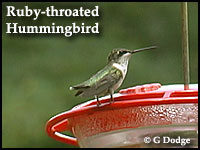The Mallards which had so discreetly nested in the Wetlands (Explore the Wild Journal, June 16-30) are being seen daily in front of the Wetlands Overlook. It appears that all 7 ducklings survived to adulthood. Canada Geese have returned to the Wetlands after a two-month absence.
On August 23 I saw a Northern Waterthrush walking on plant debris in the water among the fading Lotus plants in the Wetlands. The small, olive-brown-backed warbler with dark streaks on its undersides bounced along, bobbing its rear end up and down, looking for insects to eat. Northern Waterthrushes don’t nest in our area, but much farther north. Some warblers and other passerines are migrating at this time. Some have been on the move since July. Keep an eye out for possible migrants, especially after the passage of a cold front. Of course, I’ll be reporting anything that I see.
 Our resident Ruby-throated Hummingbirds will be leaving us soon if they’re not gone by the time this is posted. However, now is the time to keep an eye out for western species of hummingbirds. Several have already been reported elsewhere this season within the state. The one that you’re most likely to see is a Rufous Hummingbird.
Our resident Ruby-throated Hummingbirds will be leaving us soon if they’re not gone by the time this is posted. However, now is the time to keep an eye out for western species of hummingbirds. Several have already been reported elsewhere this season within the state. The one that you’re most likely to see is a Rufous Hummingbird.
It can be difficult to distinguish between immature Ruby-throated and Rufous Hummingbirds. It’s certainly possible of course, but no need to get into that here. If an adult Rufous shows up you’ll probably notice the difference right away due to the reddish brown (rufous) feathers on the back, sides, and tail. We may be seeing migrating Ruby-throats into October, but after that any hummingbird you see at the feeders in Catch the Wind is very likely to be something other than a Ruby-throated Hummingbird.